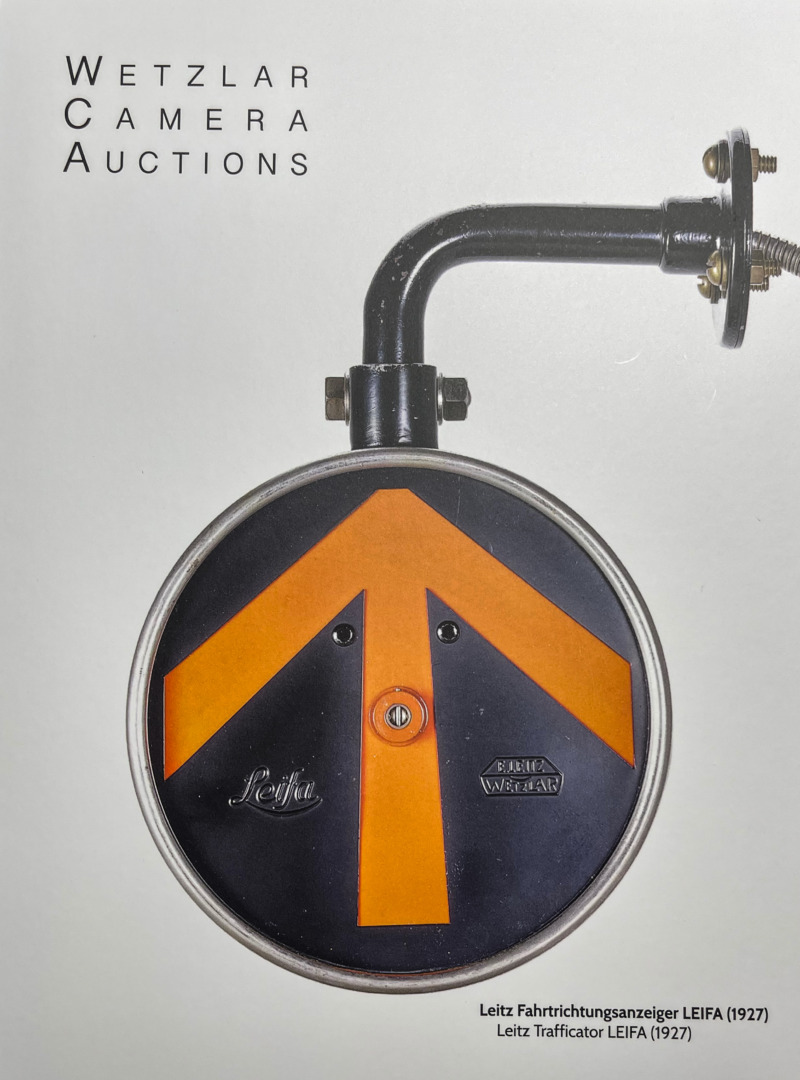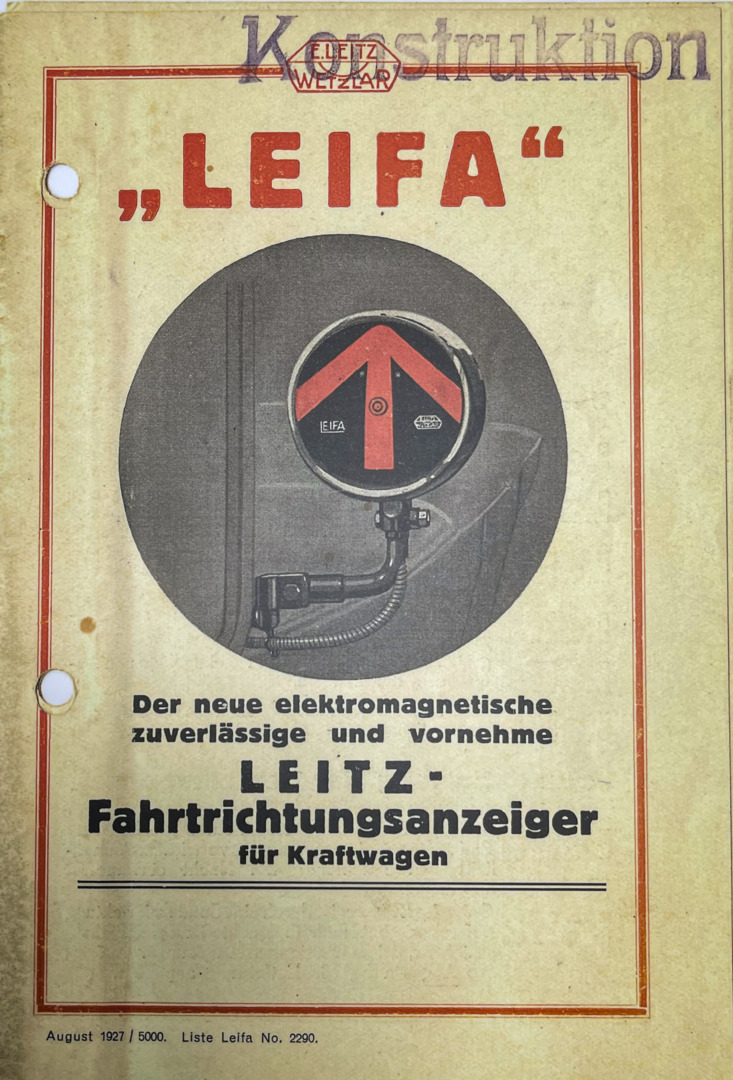Readers are wholly familiar with LEICA and the fact that the famous brand represents an acronym for LEItz CAmera. So far, so good. But what’s a LEIFA? It’s something that never caught on, that’s what. Despite the good indications, it was soon superseded by an even better idea.
The LEIFA had a very short life in the late 1920s when it was introduced as an advanced electromagnetic direction indicator device for vehicles. It was a time when companies recovering from the ravages of the First World War were tempted to diversify into new directions to help earn a crust. Leitz was no exception, and vehicle accessories must have seemed a likely wheeze to earn an extra Mark or two.
Zeiss, me too
Enter the LEItz FAhrtrichtungsanzeiger (Leitz direction indicator), known as the LEIFA for short. It is a little-known by-blow from Leitz, a company recognised primarily for its optical excellence. Strangely, though, Contax Zeiss also dallied with motoring accessories and had their own very own Fahrtrichtungsanzeiger. Perhaps there was an element of “me too” about at the time.
The Leitz version consisted of a round display unit bearing illuminated direction arrows operated electromagnetically from inside the vehicle. In its promotional material at the 1927 Berlin Transport Exhibition, Leitz boasted: “Our decades of experience in the manufacture of precision instruments allow us to introduce a direction indicator that meets all requirements for precision, reliability and operational safety, as well as offering every possible convenience in operation.”
Trafficator
This excursion by Leitz into the motoring world was short-lived. Shortly after the LEIFA was introduced, legislators in many countries began to mandate the familiar yellow trafficator arm, one on either side of the vehicle, which became universal in the industry. Gradually, this mechanical device was overtaken by the blinking indicator. In Britain, flashing indicators were first approved for road use in May 1956, although they had first appeared in 1939 on some American cars.

The good news is that you could soon be the proud owner of a near-mint LEIFA. This oddball Leitz product, one of just a few made, will feature in the forthcoming Wetzlar Camera Auction, which will take place on 9 October 2021. Organiser Lars Netopil tells me that after 35 years of collecting, he is aware of only two examples of the LEIFA — one of which is in the factory museum, and the other is the one to be offered in the October auction. It is fully functional, in beautiful original condition, with the original brochure.
Anything to sell?
Wetzlar Camera Auctions are looking for high-class collectables or entire collections at any time. If you have any items for sale, send the details to info@wetzlarcameraauctions.com. Lars tells me he can arrange a non-binding consultation to advise you on the way to proceed.

We are grateful to Olaf Nattenberg for the background information on the LEIFA. You can read his full review of the LEIFA here in German
Make a donation to help with our running costs
Did you know that Macfilos is run by five photography enthusiasts based in the UK, USA and Europe? We cover all the substantial costs of running the site, and we do not carry advertising because it spoils readers’ enjoyment. Every amount, however small, will be appreciated, and we will write to acknowledge your generosity.



Rabbit holes and how to get lost in them.
Leitz also invented the Correfot, a device for auto focus on microscopes.
This in turn led to autofocus on cameras via Minolta at first, and of course the big American court case because royalties were not paid to Leitz.
They also had a sophisticated device for use on trains and cars to measure speed, roll, pitch and yaw and other useful parameters.
We sold them to car tyre makers so they could make better tyres.
Then there was the dust measuring device to prevent fires in dusty environments such as flour storage silos.
All these things relied on optics and that is what Leitz/Leica excelled at.
Another rabbit hole.
Philip
“..to prevent fires in dusty environments such as flour storage silos..”
I was in Ipswich (UK) many years ago (1972?) to look for a barge, as I’d been told that the person to ask was Mr Orvis of the flour millers (..whatever they were called ..ah; R & W Paul..) who had a big warehouse and offices on the Ipswich waterfront.
I walked up to their quayside offices, and at that moment there was a “whoooomppff” and I think a wooden shutter blew off some of the frontage ..and the whole building spontaneously caught fire: grain dust in their flour storage.
(And then again, in New York, wanting to record police sirens for my son – around 1983 – I heard a distant siren as I stood on 23rd Street, so I turned on my pocket recorder, and waited as the siren(s) came closer and closer ..and the fire engines arrived and stopped right in front of me: the building where I stood had just caught fire as I walked towards it! ..Oooh, er ..should I even be here, or will Macfilos catch fire right this moment?!)
The early autofocus systems were a ‘right horse’s collar’ as my late father would have said. Back in the 1980s I would not touch an autofocus system and then Minolta came up with a system which sort of worked, but I still would not go near one as they were slow and clunky. I believe that Honeywell were also involved in the US court cases. I agree that optics were always a Leitz/Leica strong point, but back in the 1930s Zeiss, Schneider and Meyer etc were considered to be equally good.
On the copyright aspect, Leitz never really pursued infringements of its patents on Barnack’s original designs. The Soviets had cancelled Western copyrights and then they decided to produce ‘a Leica’ which was the FED introduced in 1934. I might add that these days those early FEDs sell for much higher prices than Leicas from the same period, probably driven by demand from well heeled Russians. After WWII the Allies cancelled all Axis patents and the main beneficiary of that was Germany’s Axis partner, Japan.
it’s a funny old world. I hope that the L Mount deal is legally sound.
William
I was going to send you this, Mike as Lars sent it to me last week. I posted it on my Instagram a few days ago. Leitz was dabbling with all kinds of things back in the 1920s. These sticking out trafficators were common up to the 1950s. These and hand signals gave driving a bit more personality. In NZ some years ago I had to resort to hand signals as the indicators on my hired car had broken. An NZ traffic cop stopped me and I asked him “ Am I doing the hand signals wrong? “. He replied “No, but you are driving too slow doing it”.
William
“..Leitz was dabbling with all kinds of things back in the 1920s..” ..remember that Oskar Barnack was introduced to Leitz by Emil Mechau? ..and that Mechau was designing a new film projector for Leitz, so Barnack was assigned to building a 35mm movie camera to shoot film to be projected through Mechau’s projector?
I was reading about ‘telecine’ machines recently – the broadcast machinery which scanned 35mm cinema films onto TV for showing on TV – and there were constant references, by the BBC telecine operators, or technicians, to the ‘Mechau’ or the Mechau mechanism ..in place of a shutter on the Mechau projectors, there were ..still are, on those machines which are still in use.. a set of revolving mirrors which project the moving film frames down the tube of the TV camera without stopping the film at every frame ..as is the case is cinemas (..or was, before ‘digital cinema’ arrived).
Mechau’s mechanism lived on long into the 1990s, or 2000s, for delivering movies onto TV screens via the 35mm telecine hardware!
..In fact, just looking up his name, via Google, I’ve just discovered Arthur Dungate’s (ex-BBC) page all about Mechau and his constant-running projection apparatus ..and this is the man who brought Barnack to Leitz!
Here we are: http://www.bbctv-ap.co.uk/mechau2.htm
I’ll have mine in the Lenny Kravitz edition, please ..brand new but well ‘worn’, or scuffed, to pretend that I’ve driven to lots of different places ..while actually sitting comfortably at home.
(Incidentally, our neighbour at the top of the road, when I was little, had a lovely two-tone Armstrong Siddeley, and I used to lie in bed when I was three or four, and watch its headlights come sweeping through my bedroom window and across my bedroom wall as he drove around the corner into our road each evening at about half past six ..I went to bed at five.)
My father owned a 1948 Armstrong Siddeley which was a far cry from his usual humble fare of Ford Popular or Anglia. That Siddeley was the most luxurious vehicle I had ever entered. The smell of the leather, the whiff of oil, the patina of the wood fascia comes back to me as I write. They don’t make ‘em like that any more.